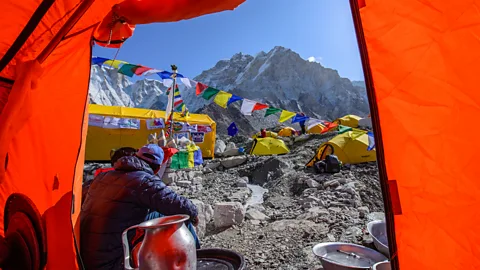Can Mount Everest really be climbed in a week?
 Getty Images
Getty ImagesA commercial expedition is planning to take clients up the tallest mountain in the world in record time with the help of xenon gas. But some in the climbing and medical world worry whether the strategy is an unnecessary gamble.
When Tenzing Norgay and Edmund Hillary made their first successful ascent of Mount Everest in 1953, it took more than two months of effort to reach the summit. In order to adjust to the extreme thin air at high altitude, the team spent several weeks acclimatising, working their way slowly upwards. After reaching Base Camp, they spent seven weeks making brief forays up and down the mountain to set ropes, lay ladders and establish ever higher camps before their assault on the summit. In short, they laid siege to the mountain.
Today, the miles of fixed ropes put along the route by teams of Sherpas and the slick logistics perfected by commercial guiding companies allow hundreds of climbers to summit Everest every year. But the time it takes for most to climb Mount Everest hasn't changed dramatically since that first ascent.
Many expeditions still recommend allowing around two months to reach the top with extensive acclimatisation, although this depends on a range of factors including the weather, traffic on the mountain and the fitness of the climber. It can take up to a week to trek to Base Camp, but once there most people need, on average, around 40 days to reach the summit. But some companies even offer fast-track expeditions that claim to get clients there in as little as two weeks.
This season, however, one guiding company has promised to slash the time even further by taking its clients to the top of the world in just one week, starting from an airport in London. They will fly to Kathmandu in Nepal, take a helicopter to Everest base camp and climb the mountain in only a few days. This way, they will skip the usual painstaking three weeks of acclimatisation in the mountains – all for around €150,000 (£127,000/$170,000) per person.
The offer, which raised more than a few eyebrows in the climbing community, came from Austrian guide Lukas Furtenbach, who will rely on an unexpected new strategy – inhaling xenon, a noble gas that is sometimes used as an anaesthetic.
The logic behind the idea is relatively simple. Around 10 years ago, it became apparent that xenon has one interesting side effect – it increases production of a protein called erythropoietin. Known for short as EPO, erythropoietin is a glycoprotein that our kidneys produce as reaction to insufficient oxygen levels. EPO fights hypoxia – a condition that occurs when the body can't get enough oxygen – by increasing the number of red blood cells and the crucial protein they carry, haemoglobin, which transports oxygen around the body. At high altitudes, this process will naturally happen after multiple rounds of going up and down the mountain – acclimatisation in other words – to slowly adapt the body to lower oxygen levels.
 Getty Images
Getty ImagesBut xenon, it is claimed, could potentially offer a shortcut. By inhaling carefully controlled doses of the gas shortly before the expedition, it may be possible to accelerate the effects of acclimatisation. Furtenbach says he successfully tested xenon himself on previous expeditions. There is, however, little published scientific evidence showing the strategy works. One recent systematic review of the scientific research, for example, found no conclusive evidence that inhaling xenon had a positive effect on the action of EPO in the human body.
"Increase in erythropoietin does nothing on its own," says Andrew Peacock, an honorary professor specialising in altitude medicine at the University of Glasgow in the UK. "The question in this case is, does it really stimulate production of red blood cells in such a short period">window._taboola = window._taboola || []; _taboola.push({ mode: 'alternating-thumbnails-a', container: 'taboola-below-article', placement: 'Below Article', target_type: 'mix' });
